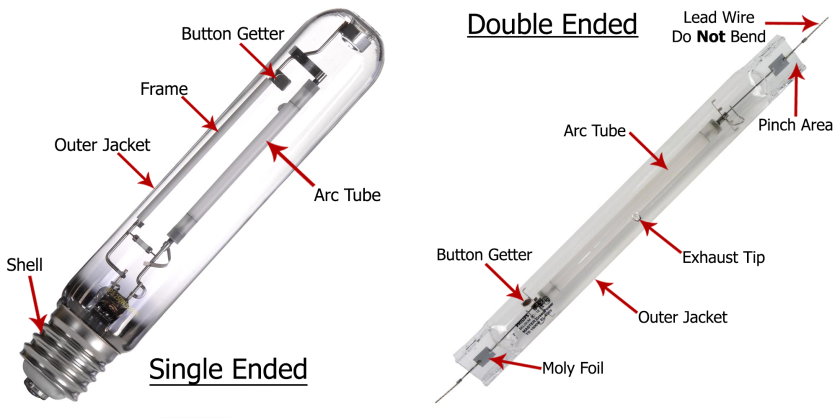
High-Intensity Discharge (HID) grow lights provide a cost-efficient light source for indoor gardening. Using very intense light, the watt to lumen ratio for HID lighting is among the highest for all types of lighting. HID lights also pump out a lot of heat and may need to be cooled. HID bulbs must be replaced often to ensure optimal spectrums are maintained, typically bulbs last 9 months to 1 year. HID lighting comes in many different wattages to accommodate different garden needs. The total wattage of a HID lighting system determines its intensity and the number and quality of the plants that it can grow. The more watts, the more intense the light.
Two types of HID grow lights can be used for indoor gardening – High-Pressure Sodium (HPS) and Metal Halide (MH). The primary visual difference between them is that metal halide light is white and the light emitted from a High-Pressure Sodium bulb is amber orange. These bulbs cannot be interchanged without changing their ballast.
There are two types of High-Pressure Sodium lights: Single-Ended and Double Ended.

Single-ended (SE) high-pressure sodium (HPS) bulbs screw in like standard light bulbs, but into a slightly wider socket called a Mogul base. The glass bulb has an elongated shape that is wide enough to accommodate its inner components. Inside the bulb, an opaque inner tube contains the part that creates light, called the arc tube. The arc tube connects to the base of the bulb with a metal “frame wire” holding it up by each end.
Double-ended (DE) HPS bulbs connect to the fixture on each end much like fluorescent tube bulbs. In this case, the inner, light-generating tube is supported by two small wires on each end of it and lacks a frame wire that crosses in front of the arc tube. Without any of the metallic structure that SE bulbs need to support the arc tube, DE bulbs are significantly thinner than SE bulbs. These bulbs also degrade slower than traditional, single-ended HPS bulbs. In fact, after 10,000 hours, double-ended lamps will still output approximately 90% of their original intensity.
With the exposed arc tube, the bulb, without any metal framing in the way, increases light delivery to the canopy of your plants. The symmetry of DE bulbs allows you to create an even spread of light much easier than is possible with SE bulbs. Not only does the lack of wireframe improve on its light delivery and reflectance, the thinner bulb also improves its optical properties.
DE bulbs, however, are not perfect. While SE bulbs are under vacuum, DE bulbs are full of nitrogen gas. The nitrogen atmosphere allows the bulb to operate at a higher temperature, which increases its efficiency. The downside of a gas-filled bulb is that the gas conducts heat from the outside of the bulb to the arc tube. Any air blowing directly on the bulb induces a temperature change in the arc tube, causing a loss in efficiency. Therefore, DE bulbs do not tolerate air blowing directly on them like in active cooling setups (aka “cool tubes” in which the SE bulb sits inside of a tube with a fan housed in the luminaire or lamp hood).
Are double ended grow lights better?
Double-ended bulbs are 25-30% more efficient than single ended bulbs, meaning they produce higher PAR ratings for the same wattage. They also last longer, retaining 90% of their output after 10,000 hours of use.
So why doesn't everyone use double-ended bulbs?
They're more expensive for one. The bulbs generally cost up to 50% more and the reflectors cost up to twice as much. They also produce more heat. Finally, reflector options are more limited, with only a few styles available for double-ended bulbs.
Growers find that double ended grow lights emit more powerful light, and in a larger quantity. These types of grow lights are typically used by commercial growers, whereas single ended grow lights are more typical in hobby grows. There are a few reasons why DE grow lights are better than SE grow lights.
Double ended grow lights are more powerful
As mentioned earlier, these emit 10-30% more intense light than SE bulbs, while simultaneously emitting more Ultraviolet and infrared light. DE grow lights can result in yields 20-50% greater than an indoor garden with an SE light. This is why they are used in commercial grow rooms and warehouses, because the weights achieved are consistently higher at the same wattage.
Double ended grow lights are more efficient
The high frequencies these lamps run on lead to a higher level of efficiency, saving money on energy bills as well. When operating two of the same grow lights with DE and SE technology, the double ended option will cost less (while putting out more usable light).
Double-ended bulbs generally give you more output and they last longer. The main drawbacks are a higher cost (the bulbs are a little more expensive and the reflectors a lot more) and heat. DE bulbs generate more heat than single-ended ones.
DE grow lights also have a significantly longer life than SE counterparts. Even after 10,000 hours of use, efficiency only drops by 10% When comparing costs of SE vs DE grow lights, factor in how much longer your DE will last.
If you have a smaller indoor garden and space is tight, we recommend a single ended grow light, as DE grow lights require more space between them and the plants due to the intensified light.If you're just starting out, go with single-ended bulbs.
























